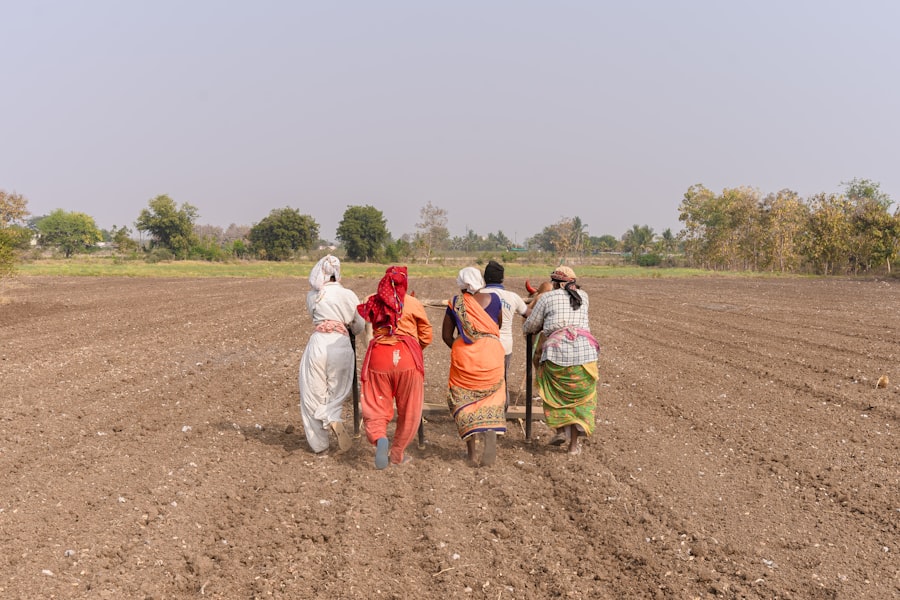The advent of the Internet of Things (IoT) has revolutionized various sectors, and agriculture is no exception.
By integrating technology into traditional farming methods, these smart farms can monitor and manage resources more efficiently, leading to improved crop yields and reduced environmental impact.
The concept of smart farming encompasses a wide range of applications, from soil moisture sensors to automated irrigation systems, all designed to create a more responsive and data-driven agricultural ecosystem. As the global population continues to rise, the demand for food production is increasing at an unprecedented rate. Traditional farming methods often struggle to keep pace with this demand, leading to overexploitation of resources and environmental degradation.
IoT-enabled smart farms present a viable solution by utilizing real-time data to make informed decisions about resource allocation, crop management, and livestock care. This integration of technology not only enhances productivity but also aligns with the principles of sustainable agriculture, ensuring that farming practices can meet current needs without compromising the ability of future generations to meet theirs.
Key Takeaways
- IoT technology is revolutionizing the agriculture industry by enabling smart farms to improve efficiency and sustainability.
- The benefits of IoT in sustainable agriculture include increased crop yields, reduced resource usage, and improved decision-making through data analytics.
- Precision farming, made possible by IoT technology, allows for the precise application of resources such as water, fertilizers, and pesticides, leading to cost savings and environmental benefits.
- IoT-enabled livestock monitoring helps farmers track the health and behavior of their animals, leading to better management and improved animal welfare.
- While IoT-enabled smart farms offer numerous environmental benefits, there are also challenges and risks to consider, such as data security and privacy concerns.
Benefits of IoT in Sustainable Agriculture
The benefits of IoT in sustainable agriculture are manifold, significantly impacting both productivity and environmental stewardship. One of the primary advantages is the ability to collect and analyze vast amounts of data from various sources, including soil sensors, weather stations, and crop monitoring systems. This data-driven approach allows farmers to make informed decisions regarding irrigation schedules, fertilizer application, and pest control measures.
For instance, by utilizing soil moisture sensors, farmers can determine the optimal time for irrigation, reducing water waste and ensuring that crops receive the necessary hydration without overwatering. Moreover, IoT technology facilitates precision agriculture, which focuses on managing variability in the field to enhance crop performance. By employing GPS-guided equipment and drones equipped with imaging technology, farmers can identify specific areas within their fields that require attention.
This targeted approach minimizes the use of chemicals and fertilizers, leading to reduced environmental impact while maximizing yield potential. Additionally, IoT systems can provide real-time feedback on crop health, enabling farmers to respond swiftly to any issues that may arise, such as pest infestations or nutrient deficiencies.
Precision Farming and IoT Technology
Precision farming represents a paradigm shift in agricultural practices, moving away from one-size-fits-all approaches toward more tailored strategies that consider the unique characteristics of each field. IoT technology plays a pivotal role in this transformation by providing farmers with the tools needed to monitor and manage their operations with unprecedented accuracy. Through the deployment of sensors and connected devices, farmers can gather data on soil conditions, weather patterns, and crop health, allowing for a comprehensive understanding of their agricultural environment.
For example, a farmer utilizing IoT technology might deploy soil sensors that measure pH levels, moisture content, and nutrient availability across different sections of a field. This data can be analyzed to create detailed maps that highlight areas requiring specific interventions. Consequently, farmers can apply fertilizers or pesticides only where needed, reducing costs and minimizing chemical runoff into surrounding ecosystems.
Furthermore, the integration of drones equipped with multispectral cameras enables farmers to assess crop health from above, identifying stress areas that may not be visible from the ground. This level of precision not only enhances productivity but also fosters a more sustainable approach to farming.
IoT-Enabled Livestock Monitoring
In addition to crop management, IoT technology has made significant strides in livestock monitoring, enhancing animal welfare and farm efficiency. Smart farms can utilize wearable devices and sensors to track the health and behavior of livestock in real time. These devices can monitor vital signs such as heart rate and temperature, providing early warnings for potential health issues.
For instance, if a cow’s temperature rises above a certain threshold, farmers can be alerted immediately, allowing for prompt veterinary intervention. Moreover, IoT-enabled systems can track feeding patterns and grazing behavior, helping farmers optimize nutrition and improve overall herd management. By analyzing data on individual animals’ eating habits and weight gain, farmers can tailor diets to meet specific nutritional needs, ultimately leading to healthier livestock and increased productivity.
Additionally, GPS tracking devices can monitor livestock movement within pastures, ensuring that animals are grazing efficiently while preventing overgrazing in certain areas. This holistic approach not only enhances animal welfare but also contributes to sustainable land management practices.
Environmental Impact of IoT-Enabled Smart Farms
The environmental impact of IoT-enabled smart farms is profound, as these technologies promote sustainable practices that mitigate negative effects on ecosystems. By optimizing resource use—such as water, fertilizers, and pesticides—smart farms can significantly reduce their carbon footprint.
Furthermore, IoT technology facilitates better waste management practices on farms. Smart sensors can monitor waste levels in storage facilities or lagoons, alerting farmers when it is time for removal or treatment. This proactive approach minimizes the risk of nutrient runoff into nearby waterways, which can lead to harmful algal blooms and other ecological issues.
Additionally, by employing data analytics to track emissions from machinery and equipment, farmers can identify opportunities for reducing greenhouse gas emissions through more efficient operations.
Challenges and Risks of Implementing IoT in Agriculture
Despite the numerous benefits associated with IoT-enabled smart farms, several challenges and risks must be addressed for successful implementation. One significant hurdle is the initial investment required for technology adoption. The cost of purchasing sensors, drones, and other connected devices can be prohibitive for small-scale farmers or those operating on tight budgets.
Additionally, ongoing maintenance and software updates may further strain financial resources. Another challenge lies in data management and cybersecurity. As farms become increasingly reliant on interconnected devices, they also become more vulnerable to cyberattacks that could compromise sensitive information or disrupt operations.
Ensuring robust cybersecurity measures are in place is essential for protecting both farm data and operational integrity. Furthermore, the sheer volume of data generated by IoT devices can overwhelm farmers who may lack the technical expertise or resources to analyze it effectively. Developing user-friendly platforms that simplify data interpretation will be crucial for maximizing the benefits of IoT technology in agriculture.
Case Studies of Successful IoT-Enabled Smart Farms
Several case studies illustrate the successful implementation of IoT technology in smart farming practices around the world. One notable example is the use of precision agriculture techniques by John Deere, a leading agricultural machinery manufacturer. The company has developed a suite of IoT-enabled solutions that allow farmers to monitor their equipment’s performance in real time while also providing insights into field conditions.
By integrating GPS technology with machine learning algorithms, John Deere’s systems enable farmers to optimize planting schedules and resource allocation based on real-time data. Another compelling case study comes from a farm in Australia that has adopted IoT technology for water management. By installing soil moisture sensors throughout their fields, the farm was able to reduce water usage by 30% while maintaining crop yields.
The data collected from these sensors allowed farmers to implement targeted irrigation strategies that aligned with weather patterns and soil conditions. This not only conserved water but also reduced energy costs associated with pumping water from reservoirs.
The Future of IoT in Sustainable Agriculture
Looking ahead, the future of IoT in sustainable agriculture appears promising as technological advancements continue to evolve. The integration of artificial intelligence (AI) with IoT systems will likely enhance decision-making capabilities for farmers by providing predictive analytics based on historical data trends. For instance, AI algorithms could analyze weather patterns alongside soil conditions to forecast optimal planting times or predict pest outbreaks before they occur.
Moreover, as connectivity improves in rural areas through advancements in 5G technology and satellite communications, more farmers will have access to real-time data analytics tools that were previously unavailable due to connectivity issues. This increased accessibility will empower even small-scale farmers to adopt smart farming practices that enhance productivity while promoting sustainability. In conclusion, the ongoing evolution of IoT technology holds immense potential for transforming agriculture into a more efficient and environmentally friendly sector.
As challenges are addressed and innovations continue to emerge, the integration of IoT into farming practices will play a crucial role in meeting global food demands while safeguarding natural resources for future generations.
A related article to “How IoT-Enabled Smart Farms Are Enhancing Sustainable Agriculture” is “The Best Software for 2D Animation” which discusses the top software options available for creating 2D animations. This article provides valuable information for those looking to enhance their digital storytelling skills and create engaging visual content. To learn more about the best software for 2D animation, check out the article here.
FAQs
What is IoT-enabled smart farming?
IoT-enabled smart farming refers to the use of Internet of Things (IoT) technology in agriculture to monitor and manage farming operations. This includes the use of sensors, actuators, and other devices to collect and analyze data for optimizing crop production, livestock management, and resource utilization.
How does IoT technology enhance sustainable agriculture in smart farms?
IoT technology enhances sustainable agriculture in smart farms by enabling real-time monitoring and control of environmental conditions, water usage, and crop health. This allows farmers to make data-driven decisions to optimize resource efficiency, reduce waste, and minimize environmental impact.
What are the benefits of IoT-enabled smart farms for sustainable agriculture?
The benefits of IoT-enabled smart farms for sustainable agriculture include improved resource efficiency, reduced environmental impact, increased crop yields, and better livestock management. Additionally, IoT technology can help farmers to implement precision agriculture practices, leading to more sustainable and profitable farming operations.
What are some examples of IoT applications in smart farming?
Some examples of IoT applications in smart farming include soil moisture sensors, weather monitoring systems, livestock tracking devices, automated irrigation systems, and crop health monitoring solutions. These IoT technologies enable farmers to collect and analyze data to make informed decisions for sustainable agriculture practices.
How does IoT technology contribute to environmental sustainability in agriculture?
IoT technology contributes to environmental sustainability in agriculture by enabling precision farming practices, reducing water and energy usage, minimizing chemical inputs, and optimizing land use. This leads to more efficient and sustainable agricultural production while minimizing negative environmental impacts.



